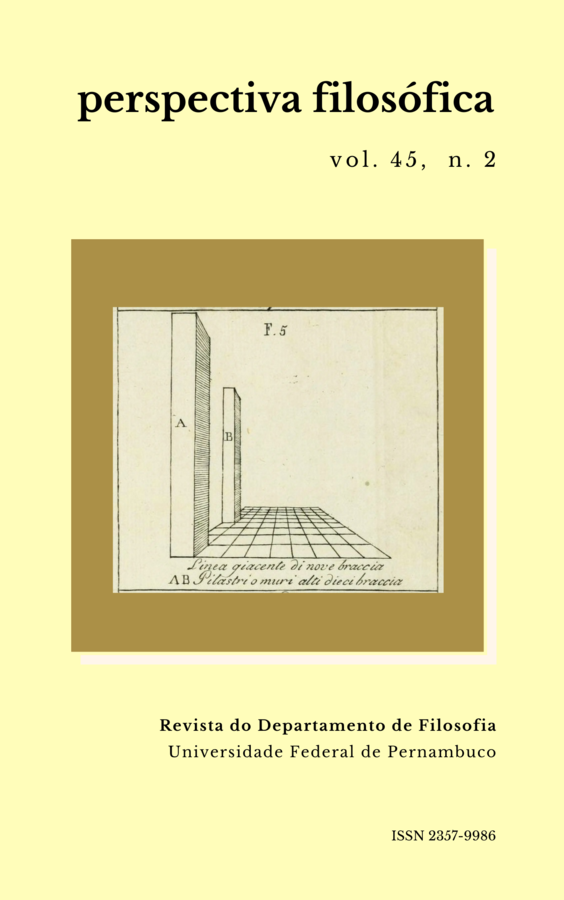On collaborative reference and the roles of the interlocutor
DOI:
https://doi.org/10.51359/2357-9986.2018.246763Palabras clave:
referência do falante, asserção, conversação, colaboraçãoResumen
Neste trabalho, eu exploro a ideia de que a colaboração é requerida para a completude de atos de referir-se ao asserir conteúdo proposicional. Essa afirmação é sustentada por um marco empírico proposto primeiramente por HH Clark e seus coautores em fins dos anos 80, mas que está correntemente sendo desenvolvido por pesquisadores nas áreas de sociologia, linguística e psicologia. Eu pretendo mostrar que, no que concerne às investigações filosóficas centradas na referência do falante, nós temos boas razões para supor que atos de referir são também direcionados ao ouvinte, como é sugerido por um trabalho recente de Kent Bach. Consequentemente, nós precisamos de uma teoria não-idealizada de asserções compatível com a observação empírica de como conversas diádicas reais funcionam. Para isso, eu enfoco em uma crítica à teoria da asserção de Stalnaker e ofereço formas de superar as dificuldades por ela trazidas, defendendo uma visão colaborativa da performance de asserções e dos atos de referência do falante.
Citas
AUSTIN, J. L.How to do things with words. Oxford university press, 1975.
AUSTIN, J. L.Philosophical papers, Oxford University Press, 1979.
BACH, K. On referring and not referring.Reference: Interdisciplinaryperspectives, Ed. Jeanette Gundel and Nancy Hedberg. Oxford: Oxford U,p. 13-58, 2008.
CLARK, H. H.; SCHAEFER, E. F. “Dealing with overhearers.”Arenas oflanguage use, pp. 248-297, 1992.
CLARK, H. H.; WILKES-GIBBS, D. “Referring as a collaborativeprocess.”Cognition, vol. 22, no 1, pp. 1-39, 1986.
DREW, P. “‘Open’ Class Repair Initiators in Response to SequentialSources of Trouble in Conversation.” Journal of Pragmatics vol. 28, pp. 69–101, 1997.
GLUCKSBERG, S.; KRAUSS, R.M.; HIGGINS, E.T. “The development ofreferential communication skills”. In F.E. Horowitz (Ed.), Review of childdevelopment research. Vol. 4, pp. 305-345, Chicago: University of ChicagoPress, 1975.
GOODWIN, C. Conversational organization: Interaction between speakersand hearers. New York: Academic Press, 1981.
GRICE, H. P. William James Lectures. Harvard University, pp. 41-58, 1967.
JEFFERSON, G. “A case of precision timing in ordinary conversation”.Semiotica, vol. 9, pp. 47-96, 1973.
KITZINGER, C. “Repair.” In SIDNELL, J. & STIVERS, T. (eds) TheHandbook of Conversation Analysis. John Wiley & Sons, Ltd, pp. 229–56,2013.
KORTA, K; PERRY, J.Critical pragmatics: An inquiry into reference andcommunication. Cambridge University Press, 2010.
LERNER, G. H. “On the Place of Linguistic Resources in the Organizationof Talk-in-Interaction: Grammar as Action in Prompting a Speaker toElaborate.” Research on Language & Social Interaction vol. 37 (2), pp. 151–84, 2004. doi:10.1207/ s15327973rlsi3702_3.
RUSSELL, B. “On Denoting”, Mind, vol. 14, pp. 479–493, 1905.
STALNAKER, R. C. ‘Presuppositions’, Journal of PhilosophicalLogic, vol.2, pp. 447-457, 1973.
STALNAKER, R. C. ‘Pragmatic Presuppositions’, in Milton K. Munitz andPeter K. Unger (eds.), Semantics and Philosophy, New York UniversityPress, New York, 1974.
STALNAKER, R. C.Assertion. Blackwell Publishers Ltd, 1978
STALNAKER, R. C.Context and content: Essays on intentionality inspeech and thought., 1999.
STALNAKER, R. C. “Common Ground’, Linguistics and Philosophy vol.25, n.5-6, pp. 701-721, 2002.
STRAWSON, P. F. “On referring”, Mind, vol. 9, pp. 320–44, 1950.
STRAWSON, P. F. “A Reply to Mr. Sellars”, Philosophical Review, vol. 63,pp. 216–231, 1954.
STRAWSON, P. F. “Identifying reference and truth‐values.”Theoriavol.30,n. 2, pp. 96-118, 1964.
Descargas
Publicado
Número
Sección
Licencia
A Revista Perspectiva Filosófica orienta seus procedimentos de gestão de artigos conforme as diretrizes básicas formuladas pelo Conselho Nacional de Desenvolvimento Científico e Tecnológico (CNPq). http://www.cnpq.br/web/guest/diretrizesAutores que publicam nesta revista concordam com os seguintes termos:
Os autores mantém os direitos autorais e concedem à revista o direito de primeira publicação, sendo o trabalho simultaneamente licenciado sob https://creativecommons.org/licenses/by/4.0/deed.pt_BR que permite o compartilhamento do trabalho com reconhecimento da autoria e publicação inicial nesta revista.
Os autores têm autorização para assumir contratos adicionais separadamente, para distribuição não-exclusiva da versão do trabalho publicada nesta revista, com reconhecimento de autoria e publicação inicial nesta revista (Consultar http://opcit.eprints.org/oacitation-biblio.html).

Esta revista está licenciada com uma Licença Creative Commons Atribuição 4.0 Internacional.













